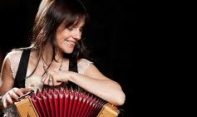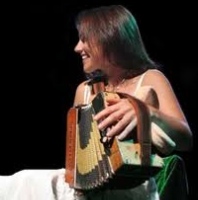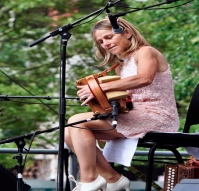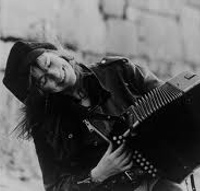- About Us
- Columns
- Letters
- Cartoons
- The Udder Limits
- Archives
- Ezy Reading Archive
- 2024 Cud Archives
- 2023 Cud Archives
- 2022 Cud Archives
- 2021 Cud Archives
- 2020 Cud Archives
- 2015-2019
- 2010-2014
- 2004-2009
 |
The Cud Music Review- |
Sharon Shannon at The Clarendon Guesthouse, Katoomba, NSW, January 8, 2012
Community knowledge about an instrument and a genre of music is pretty low when reviewers in national dailies fail to give appropriate details about performances. Fortunately, in the case of the button accordion, Sharon Shannon has been attracting popular interest by enlarging the repertoire and collaborating with an increasing range of musicians. At the Clarendon Guesthouse in Katoomba on 8 January, an appreciative audience enjoyed a dazzling demonstration of Shannon’s virtuosity as a performer and skill as an arranger and presenter.
The diatonic button accordion is a true ‘folk’ instrument, in that it has appealed to traditional musicians around the British Isles and Australia. It is neither a concertina nor a piano accordion, but an instrument in its own right. Most buttons play distinct notes on push and pull. In its simplest form, the melodeon, the button accordion has ten buttons on the right hand and four on the left. The right generally plays the melody line or around it with arpeggios – chords spread as they may be on a guitar. The left has chords and bass notes.
Historically, many traditional musicians have not read music, and have played by ear. As the arrangement of notes on the accordion resembles that on the diatonic harmonica, the accordion has been a friendly instrument for the self taught musician. If you can play a tune on the mouth organ, you can transfer the knowledge to the accordion.
Some accordions have three rows. Those most commonly played by folk performers have two rows. Single row instruments are restricted in that they usually have no accidentals and can play only in one key. The benefit of having two rows is that you get two keys. It is common to find accordions or ‘boxes’ in combinations such as D and G or G and C. These are common because other folk instruments such as the fiddle and the tin whistle, favour these keys, and group playing is one of the great joys of folk music.
Sharon Shannon’s instruments are tuned slightly differently. Instead of relying on always encountering the same couple of keys, Irish players have adopted a system of tuning in which the two rows are a semi-tone apart, for example, B and C or C and C sharp. Shannon plays Castagnari accordions and the manufacturer’s catalogue lists some of its models as Irish boxes. The result is that the instrument has every note on the scale, naturals, sharps and flats without exception, at least on the right hand. These instruments are less attractive to the untrained musician, because either the B or C sharp row is there as a repository of accidentals. Much more fingering across the rows of buttons is needed.
In the hands of a player as skilled as Sharon Shannon, the arrangement of rows is no handicap. On the contrary, it presents unlimited opportunities. To watch Shannon play is an experience very similar to watching any musician whose instrument seems like a natural extension of her or his body – and spirit. The comfort, speed and sureness with which her fingers fly across the buttons does make it look easy, comparable to the way we might clap to join in with a tune. It is the same deceptive ease that emanates from the performances of players on better known instruments – John Williams or Julian Bream on classical guitar for instance. While there are many other very strong accordion players around, Sharon Shannon belongs in a class of her own.
On her current Australian tour Shannon is joined by Jim Murray on acoustic guitar, Jack Maher on electric guitar and Sean Regan on fiddle. For dyed in the wool folkies, this combination of instruments highlights the accordion better than Shannon’s big band does with its drums and brass. The program at the Clarendon was very well balanced, with familiar tunes and some newer ones. Jack Maher sang a couple of songs including one of his own composition, Jim Murray showed why he is one of the most sought after collaborators in the business and Sean Regan did some percussive tricks with his mouth that throat singers and dijeridu players would envy.
These variations on the theme of dazzling accordion music added spice to the evening. The basis of the band’s success however, emanated from Shannon’s brilliance and the ensemble that the four musicians displayed. 
There were tunes Shannon has made famous, either on the series of CDs emanating from Eleanor McEvoy’s song ‘A Woman’s Heart’ or on her own ‘Libertango’ album. They ranged from the traditional standards such as ‘Blackbird’ to the more recent ‘Bungee Jumpers’. They included jigs, reels and hornpipes that were originally intended for other instruments, but which Shannon has brought into the accordion repertoire. Perhaps, that should read, brought into her repertoire because few players would be capable of making these tunes sound so appropriate to the accordion. At the other extreme were
Shannon tunes such as ‘The Flying Circus’, which seemed so suited to the accordion that any other versions will pale in comparison.
The intimacy of the setting at the Clarendon added to the enjoyment of the evening. If you were lucky enough to be on Shannon’s right hand, you could appreciate fully the thousands of notes that went into every tune. You were involved in the communications between the players as they played solo breaks. You could imagine Shannon sitting in your lounge room – or probably your kitchen, given the music she was playing. Another aspect of the small venue is that we groupies had no difficulty in finding the players at the stage door after their encore. Sharon Shannon, despite her pre-eminence in her musical field, has none of the slickness associated with the international superstar. A folk instrument could not have a better ambassador.
